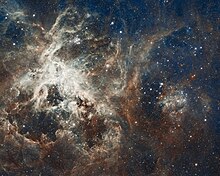파일:30 Doradus, Tarantula Nebula.jpg

미리 보기 크기: 749 × 599 픽셀 다른 해상도: 300 × 240 픽셀 | 600 × 480 픽셀 | 960 × 768 픽셀 | 1,280 × 1,024 픽셀 | 2,560 × 2,048 픽셀 | 20,323 × 16,259 픽셀
원본 파일 (20,323 × 16,259 픽셀, 파일 크기: 99.35 MB, MIME 종류: image/jpeg)
파일 역사
날짜/시간 링크를 클릭하면 해당 시간의 파일을 볼 수 있습니다.
| 날짜/시간 | 섬네일 | 크기 | 사용자 | 설명 | |
|---|---|---|---|---|---|
| 현재 | 2012년 7월 9일 (월) 03:35 |  | 20,323 × 16,259 (99.35 MB) | Prof. Professorson | Higher resolution, converted from http://spacetelescope.org/static/archives/images/original/heic1206a.tif. |
| 2012년 4월 19일 (목) 21:13 |  | 2,340 × 1,847 (2.52 MB) | Dipankan001 |
이 파일을 사용하는 문서
다음 문서 2개가 이 파일을 사용하고 있습니다:
이 파일을 사용하고 있는 모든 위키의 문서 목록
다음 위키에서 이 파일을 사용하고 있습니다:
- af.wikipedia.org에서 이 파일을 사용하고 있는 문서 목록
- ar.wikipedia.org에서 이 파일을 사용하고 있는 문서 목록
- be-tarask.wikipedia.org에서 이 파일을 사용하고 있는 문서 목록
- bn.wikipedia.org에서 이 파일을 사용하고 있는 문서 목록
- crh.wikipedia.org에서 이 파일을 사용하고 있는 문서 목록
- cs.wikipedia.org에서 이 파일을 사용하고 있는 문서 목록
- cv.wikipedia.org에서 이 파일을 사용하고 있는 문서 목록
- de.wikipedia.org에서 이 파일을 사용하고 있는 문서 목록
- en.wikipedia.org에서 이 파일을 사용하고 있는 문서 목록
- Starburst region
- Wikipedia:WikiProject Astronomy/Recognized content
- Wikipedia:Featured pictures/Space/Looking out
- Wikipedia:Teahouse/Guests
- Wikipedia:Teahouse/Guest profile summary
- Wikipedia:Teahouse/Guest profile summary/Avatars
- Wikipedia:Teahouse/Guests/Left column
- Wikipedia:Teahouse/Guests/Right column
- User:The Determinator/Userpage/Top/Image
- Wikipedia:WikiProject Astronomy/Recognized astronomy content
- Wikipedia:Teahouse/Guest/Featured/21
- Wikipedia:Teahouse/Guest/Featured/22
- Wikipedia:Teahouse/Guest book/Archive 13
- Wikipedia:Teahouse/Guest book/Archive 14
- Wikipedia:Teahouse/Guest book/Archive 15
- Wikipedia:Teahouse/Guest book/Archive 16
- Wikipedia:Teahouse/Guest book/Archive 17
- Wikipedia:Teahouse/Guest book/Archive 18
- Wikipedia:Teahouse/Guest book/Archive 19
- Wikipedia:Teahouse/Guest book/Archive 20
- Wikipedia:Teahouse/Guest book/Archive 22
- Wikipedia:Teahouse/Guest book/Archive 23
- Wikipedia:Teahouse/Guest book/Archive 24
- Wikipedia:Teahouse/Guest book/Archive 26
- Wikipedia:Teahouse/Guest book/Archive 28
- Wikipedia:Teahouse/Guest book/Archive 29
- Wikipedia:Teahouse/Guest book/Archive 30
- Wikipedia:Teahouse/Guest book/Archive 31
- Wikipedia:Teahouse/Guest book/Archive 32
- Wikipedia:Teahouse/Guest book/Archive 34
- Wikipedia:Teahouse/Guest book/Archive 35
- Wikipedia:Teahouse/Guest book/Archive 36
- Wikipedia:Teahouse/Guest book/Archive 37
- Wikipedia:Teahouse/Guest book/Archive 39
- Wikipedia:Teahouse/Guest book/Archive 40
- User:LucasTichawa
- Wikipedia:Teahouse/Guest book/Archive 42
- Wikipedia:Teahouse/Guest book/Archive 43
- Wikipedia:Teahouse/Guest book/Archive 44
- Wikipedia:Teahouse/Guest book/Archive 45
- Wikipedia:Teahouse/Guest book/Archive 0
이 파일의 더 많은 사용 내역을 봅니다.


